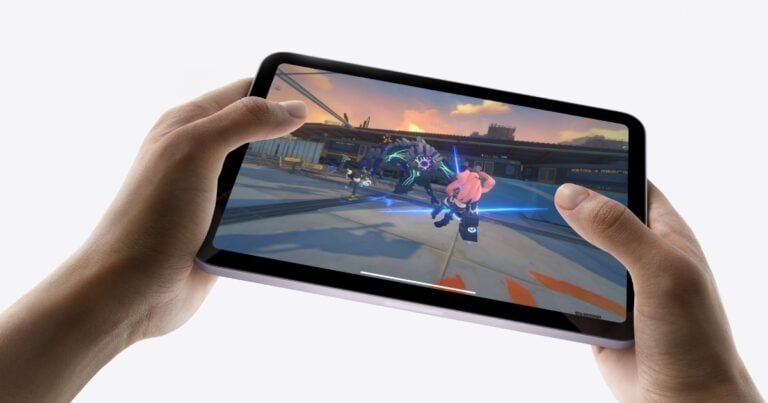Thoughts on the updated iPad mini after a few weeks, plus impressions on the new trading card game ‘Altered’.
The iPad mini has always been one of Apple’s most interesting devices – a jack of all trades that blends productivity, mid-range gaming and media capabilities with a screen that sits smack-bang in the middle of the tech company’s stacked pack. Now, after a number of years, it’s been updated once again and I’ve spent a pretty surprising few weeks with it.
Straight out of the box you’re likely not going to be shocked to discover that the iPad mini looks pretty much as you’d expect it to. Makes sense considering the changes between this iteration and its 2021 predecessor are relatively few. The base storage has been bumped up, it uses USB-C, and includes compatibility with the Apple Pencil Pro, which turns the iPad mini in a productivity powerhouse that’s capable of sketching drawings thanks to features like barrel roll.
The 8.3″ screen still looks great with its Liquid Retina display, but I really would have loved to have seen the introduction of a 120 Hz refresh rate for smoother scrolling and the introduction of FaceID. Still, the iPad mini remains a compact formfactor that is comfy in the hands and incredibly easy to navigate. The size of the mini quickly made it my ideal choice not just for bedtime viewing or playing, but my daily commute into the office as well thanks to its much smaller footprint that could still surpass my Pixel 9 Pro Fold.
One of the biggest updates for gamers though is the inclusion of the A17 Pro chip – first used inside the iPhone 15 Pro. Considering Apple has been making some big moves to break into the AAA market, this is a smart move and easily boosts the iPad mini’s gaming capabilities across the board. Now titles like Resident Evil 2, Resident Evil Village, Death Stranding and Assassin’s Creed Mirage can all be played via the iPad mini – something it’s older sibling simply couldn’t manage.
When it came to actually putting these titles to the test, it was pretty darn capable as well, with most of my settings listed towards either medium or high. I did notice a bit of slowdown when the action got a little too busy, especially for newer titles like Death Stranding, but for the most part it was entirely serviceable. That said, if you are looking for premium performance, this device does lack the extra grunt of the newer A18 chipset found in the iPhone 16 series, so you are going to be slightly behind the eight ball.
Love Film & TV?
Get your daily dose of everything happening in music, film and TV in Australia and abroad.
Move away from the big-name title’s though and the iPad mini shines brighter. I trialled a wealth of games available via a Netflix subscription (ranging from Deaths Door to GTA Vice City) and never missed a beat, leaving me to appreciate the extra screen real estate. The same can be said for Apple’s own oft-forgotten service, Apple Arcade, which has its own titles to enjoy like Monument Valley and Rise of the Golden Idol, all tailor-made for touch inputs. And that’s not even mentioning how the iPad mini has become my new Balatro and Pokémon machine thanks to the introduction of Balatro+ and Pokémon TCG Pocket.
The one downside to all this? Well, even though there’s a total abundance of games available for the iPad mini, actually playing the larger-scale titles can be slightly more challenging. That’s because the number of controller accessories feels a lot more limited compared to the iPhone. Mainstays like BackBone and GameSir just don’t open wide enough to fit the form factor, leaving something like Razer’s Kishi Ultra as one if your few options. Alternatively, Apple does allow you to pair up a DualSense or Xbox controller to the iPad mini and doing so is incredibly easy and perfect for household play, it’s a lot less practical for whenever I’m on public transport – the main scenario for mobile gaming.
Outside of gaming, one of the other big area Apple is pushing is AI thanks to Apple Intelligence. The only problem with this is that we’re still waiting to actually see how this feature set develops, with many of the capabilities still waiting in the wings. So then, is now a good time to invest in the new iPad mini? Honestly, that answer is going to vary depending on your use case. It’s a tiny wonder that can handle way more than it has any right to, and unless you’re a power user it’s probably going to be just right. The iPad mini now has its own spot on my bedside table, and imagine it won’t be dethroned anytime soon.
The iPad mini is available now from $799. You can grab one from the Apple Store here.
Also out now…
Altered TCG
There’s been a fair bit of buzz around Altered, especially after the trading card game garnered $7 million on Kickstarter when it first hit the scene. Now the full game has been released and it’s an interesting proposition that smartly deviates from much of the competition.
Altered occurs in a world after a great planetary cataclysm takes place (known as the Confluence). Effectively, said cataclysm merged reality with the “world of stories” – leading to a new civilisation with six core factions in place that must learn to co-exist. It’s a cool setup that allows for a lot of creative flexibility and a rich lore to develop over time. But while its story might sound slightly traditional, Altered’s gameplay is anything but.
The biggest deviation is with the lack of combat. There’s no attacking, nor will you be trying to sap life points from your opponent. In fact, you’re not really trying to fight your opponent at all. Instead, Altered is all about exploration and adventure. Games operate like a race, and are won or lost based on how quickly you’re able to unite your deck’s Hero and their Companion from their respective expeditions.
It’s an interesting change of pace that is actually refreshing for the competitive card scene, although it is admittedly a little confusing to wrap your head around during the early stages. There are multiple factions to juggle, day cycles to remember and an underling strategy that involves considering what cards you should hold onto and what can be better utilized elsewhere. Like I said, it’s a lot. You will have an instruction pamphlet provided with your starter decks to help bring you up to speed (alongside a paper play mat), but honestly it might be easier to simply watch a few online tutorials or just learn via trial and error after a handful of games.
I also need to commend the art. I played around with the Axiom and Lyra starter decks and both featured sole truly unique designs that wholeheartedly embraces Altered’s fantasy aesthetic with a painterly approach that feels very unique against the likes of something like Magic: The Gathering. I also appreciate the fact that you own your entire collection digitally. Each card has a QR code placed in the right-hand corner, allowing you to easily sync it with the Altered Companion app and then play online against others. Even more interesting is the fact that you can trade and sell your cards online via a digital marketplace. It’s a fascinating space to watch evolve.
The biggest question mark surrounding Altered though is going to be around its longevity. Having been backed via Kickstarter, it’s future is going to depend on continued fan support, especially without the oodles of cash that bigger behemoths like Disney or Wizards of the Coast can throw around. Fingers crossed that Altered’s unique placement in the market help it to thrive, because it’s an enjoyably refreshing game worth checking out.
Altered is available now and starts from $6.95 via the Gamesmen.
For more on this topic, follow the Gaming Observer.

































